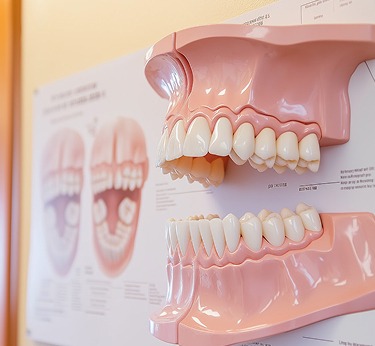
Crowns are also known as “tooth caps” or “dental caps”. They are dental restorations that cover over and encase the teeth on which they are cemented. Since they cup over the entire portion of a tooth that lies above the gum line, a crown becomes the tooth’s outer surface.

Benefits
Crowns help restore teeth to their original shape; They strengthen teeth; They improve the cosmetic appearance of the teeth.
Who is this procedure for?
People who have badly damaged teeth; People who wish to cover misshapen or badly discolored teeth.
You can not have crowns done if you have uncontrolled type II diabetes. The reason behind this is that the healing process that follows any surgical procedure is delayed because of the poor peripheral blood circulation.
The tooth and the gum tissue that surrounds it will then be anesthetized. Next, the tooth will be filed down to make room for the crown; the amount of tooth that is removed depends on the type of crown that will be used. If a large part of the tooth is missing the dentist will use filling to build up the tooth in order to support the crown. Once the tooth is reshaped, the dentist will make impressions of the tooth, as well as of the tooth above/below the receiving tooth. This is done to make sure the crown will not affect the patient’s bite.
The dentist will make a temporary crown to cover the tooth while the crown is being made. The crown will be manufactured at a dental laboratory and will be ready in about 3 weeks.
During the second visit the dentist removes the temporary crown and checks the fit and color of the new crown. If they are right, the patient is locally anesthetized and the permanent crown is cemented in its place.
There is no special care required when it comes to crowned teeth. However, the tooth under the crown is not protected from gum disease or decay, so a good oral hygiene is absolutely necessary. Flossing daily around the crown area is strongly recommended.
During the initial visit, the dentist will take X – rays to check the roots of the tooth that will receive a crown and the bone that surrounds it. Root canal treatment has to be performed if the tooth is decayed.


Porcelain Veneer Ahmedabad Veneers are wafer–thin pieces of porcelain that are bonded onto the front side of the teeth. They represent the perfect Cosmetic Solution for stained, chipped or slightly misaligned teeth. They are also called porcelain veneers, Dental Veneers or dental porcelain laminates.
Benefits
Veneers create a very lifelike tooth appearance They are resistant to staining.

During the second visit the veneers are tried in and if they are satisfactory they are bonded in place. First they are placed on the teeth with water or glycerin to check the fit and the color. Next the teeth are cleansed with chemical substances to get a durable bond. A special glue (cement) is used for the bonding. At the end a light beam is used to harden the cement.
Once the veneers are fitted there are only minor adjustments that can be done. That is why dentists choose to wait for about a week before they make any changes. During this third visit they check and polish the veneers if needed.